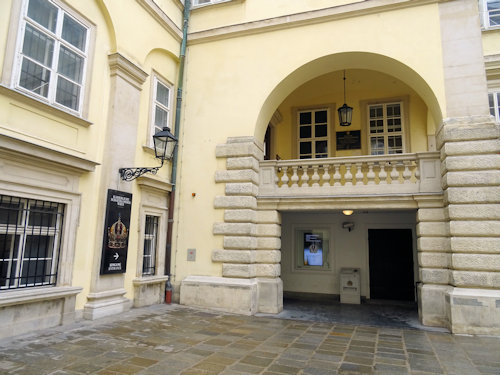The main door hints at what to expect in the Schatzkammer (Imperial Treasury): it looks suited to a bank vault. Behind it, crown jewels and relics from centuries of Habsburg rule.
- Highlights include:
- Crown of the Holy Roman Emperor
- Habsburg imperial crown
- …and so much more
- Very central location so easy to visit
- Book Imperial Treasury tickets* online
- See also:
- My Schatzkammer highlights
- The wider Hofburg Palace complex
Treasures and relics

(The innocent-looking entrance in the Schweizerhof courtyard of the Hofburg)
The Schatzkammer houses a number of items for which the word “priceless” really does apply. Most stem from the time of the Habsburgs, the Holy Roman Empire, and the Austrian Empire.
The displays divide across secular and ecclesiastical sections, though everything is part of one complex.
What you get is a trip through over 1000 years of history in the form of imperial status symbols.
Expect crowns and ceremonial robes, swords and scepters, gems and jewelry, relics and rich altar tapestries.
The collection represents a literal treasure trove for history aficionados, since the exhibits put you in touch with momentous events of the past.
For example, imagine the coronation of a Holy Roman Emperor hundreds of years ago…
The ceremonial robes are inside the Schatzkammer.
And the crown, too.
Imagine the great Emperor Charlemagne seeking inspiration in the pages of his bible in the early 9th century.
The bible’s here.
Or imagine Marie Louise, wife of Napoleon, leaning over her son’s throne-like cot on a cold evening, singing lullabies in accented French.
The cot’s here.

(Inside the Schatzkammer; press photo ©KHM-Museumsverband)
For those of a Christian leaning, some of the relics will inspire awe.
Since no records go back far enough, we have no proof of authenticity, of course, but the relics’ stories, acquisition history (dating back as far as the 12th century and beyond) and presentation (in displays of exquisite workmanship) have value in their own right.
The Schatzkammer has so many highlights, I’ve given them their own article.
Tickets & visitor tips
Tickets are available from the venue or online sources.
(Booking service provided by Tiqets.com*, who I am an affiliate of)
A few tips:
- When booking, consider the combination ticket with the Kunsthistorisches Museum (which has more treasures from the past in the Kunstkammer chamber of wonders. Many items there would not look out of place among the crown jewels.
- For other historical religious items, try the Dom Museum (just outside the main cathedral). Both the Kunsthistorisches Museum and Dom Museum are a relatively easy walk from the Schatzkammer.
- For another impressive treasury, take a trip to Klosterneuburg abbey (at the edge of Vienna). A basic entry ticket includes the 3-room Schatzkammer with such delights as the Archducal Coronet from the early 17th century and rare artefacts from over a 1000 years ago
- An audio guide offers good value, with extensive background information on many of the items on display.
- Benches dot the secular section, offering a place to sit and take it all in (or listen to your audio guide).
- On my last visit, each room in the secular Imperial treasures had one or more useful summaries in English that explained the gallery’s theme and context, but also added specifics about some of the main items within. Display labels were also bilingual.
- The ecclesiastical Imperial treasures were, however, more or less German-only: an audio guide or guide book perhaps makes sense here. You might want either, anyway, to give more historical context to what you’re seeing.
- Don’t always expect the best pieces to get the most prominent positions. That small unobtrusive item or display might be something quite spectacular.
- The shop inside the Schatzkammer entrance hall has the usual souvenirs, but also a collection of jewellery priced a little lower than the items in the rooms beyond.
- A Vienna Pass (see my review) also gives you one-time free entry.
The Imperial Treasury actually sits in the middle of the Habsburg’s Hofburg complex. The Hofburgkapelle (Imperial Court Chapel) and Schweizertor (Renaissance gateway) are next door and other nearby sights include, for example:
- The National Library’s State Hall (gorgeous Baroque library)
- The Sisi Museum (explore the life of Empress Elisabeth)
- The Spanish Riding School (with public trainings and stable tours)
- The Franz II/I statue (whose crown you see inside the treasury)
- The Neue Burg (full of museums and historical collections)
Schatzkammer travel tips
You pretty much pass it as you walk through this central complex.
The surrounding area is largely pedestrianised, but not far from many central stations and stops. For example:
Subway: A short walk from either Stephansplatz (U1 and U3 lines) or Herrengasse (U3 line) stations
Tram/bus: Take the D, 1, 2 or 71 tram to the Burgring stop. Or bus lines 1A or 2A to Michaelerplatz or Habsburgergasse
Address: Schweizerhof, Hofburg, 1010 Vienna | Website
